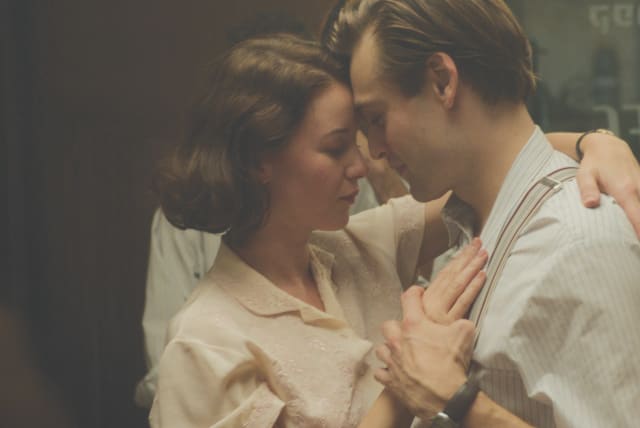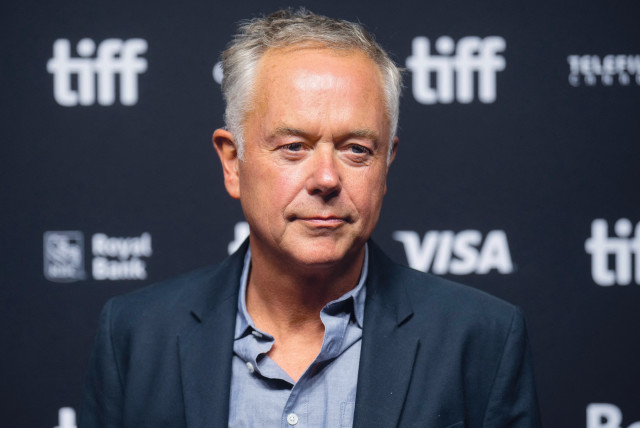Forbidden Tel Aviv love in a complicated time

While the movie celebrates the spirit of Tel Aviv 80 years ago, it was actually filmed in Puglia, Italy, where Winterbottom and his team found buildings that were “new, white, and low-rise."
Shoshana, the latest film from British director Michael Winterbottom, which opened throughout Israel on January 25, tackles a complex story of a love affair between a Jewish woman and a British police officer in Tel Aviv in the late ’30s and early ’40s, a subject and period so complex and one that arouses so much emotion that most filmmakers – both from Israel and abroad – have chosen to ignore it completely.
The one well-known Israeli movie about fighters in a pre-state militia, Avi Nesher’s 1984 Rage and Glory, drew condemnation from both the right and the left when it was released, and was even denounced in the Knesset.
There was one international movie about this period, the schmaltzy 1986 English-language romance, Every Time We Say Goodbye, directed by Moshe Mizrahi, which starred Tom Hanks as an American pilot in the Royal Air Force in Jerusalem during World War II who falls in love with a Sephardi girl.
But although filmmakers have ignored this extremely dramatic era for decades, Winterbottom has chosen to make an ambitious and complex film that looks at the real-life (and relatively little-known) love story between Shoshana Borochov (Irina Starshenbaum), an aspiring journalist and daughter of Ber Borochov, one of the founders of the socialist Zionist movement, and Tom Wilkin (Douglas Booth), a British police officer based in Tel Aviv.
As their fraught love story plays out – their real-life relationship lasted 11 years – other characters that embody the pressures on the couple from different sides of the political spectrum are caught up in the action.
Notably, Avraham Stern (Aury Alby), one of the Irgun and Lehi leaders, advocates for armed resistance against British rule and against Arabs, and Geoffrey Morton (Harry Melling), a British police assistant superintendent, felt that the British should crack down on both the Arabs and the Jews as hard as possible and that Palestine should remain part of the British Empire.
The movie, which may send even Israelis to Wikipedia to look up details of the period, uses newsreel-type narration and clips to clarify the various factions and the historical timeline.
Winterbottom said he became interested in telling this story after visiting Israel in 2008 when there was a tribute to him at the Jerusalem Film Festival. “That trip to Jerusalem was the starting point for getting interested in that time and place... Whilst there, I read a book by Tom Segev, One Palestine Complete, and that was how I got interested in the time when Britain was the occupying power in Palestine, from the First World War onwards. But from then it was a slow process to get to the point where we had the story of Shoshana... It’s a time and place that people in Britain really know very little about.”
Winterbottom has had an eclectic career
One of Britain’s most acclaimed filmmakers, Winterbottom has had an eclectic career in which he has often been drawn to stories set in conflict zones, among them Welcome to Sarajevo (1997), In This World (2002), and The Road to Guantanamo (2006). His 2007 film, A Mighty Heart, starred Angelina Jolie in a dramatization of Mariane Pearl’s memoir about the kidnapping and murder of her husband, Daniel Pearl, a Wall Street Journal Reporter, by Pakistani Islamic terrorists. (Pearl’s father, Judea Pearl, felt that the film showed “moral relativism,” an assertion Winterbottom has challenged.)
But Winterbottom has another side, making films that focus on love and relationships, such as 9 Songs, about a couple with an intense sexual connection; Wonderland (1999), about a family of Londoners who struggle to find love and connection; Trishna (2011), a reworking of Thomas Hardy’s Tess of the D’Urbervilles, set in contemporary India, and many others.
These disparate sides of his career have come together in Shoshana. He and his co-screenplay writers, Laurence Coriat and Paul Viragh, began to delve into the period and came across the story of Shoshana Borochov and Tom Wilkin. “I thought that would be a really simple story but one which, just by looking at it, you could understand the way in which political pressures and violence impacted their lives... [Their story] showed a lot about the ways that violence and extremism polarize people into opposing camps.”
Winterbottom was also intrigued by the cosmopolitan atmosphere of Tel Aviv during that period, and he was drawn to the idea of telling a love story set there. “There is a lot of dialogue in the film about how, at some point, Tom is going to have to choose sides, because Tom is British, he’s a policeman, he’s there supposedly enforcing British rule but at the same time, he’s fallen in love, not only with Shoshana as a woman, as an individual but also he’s fallen in love with the world of Tel Aviv, the energy, the youth, the cosmopolitan nature of Tel Aviv, the excitement in ideas and politics.”
While the movie celebrates the spirit of Tel Aviv during this era, it was actually filmed in Puglia, Italy, where Winterbottom and his team found buildings that were “new, white, and low-rise,” since much of Tel Aviv is now too built up to replicate the White City of 80 years ago.
Winterbottom was impressed by what he learned about Tel Aviv in that period. “A lot of people in Tel Aviv were on the left, women had a really strong role, it was one of the more egalitarian places and societies in those days and it was really a tiny minority who, like Avraham Stern, believed in violence. Shoshana believes, as did most people in the Haganah [the mainstream group that advocated for Jewish statehood, which she supported], as did most of her friends and colleagues, in wanting to build Israel through political means,” he said.
Segev’s book was particularly helpful, he said, because “it showed a lot of the private conversations going on between the British when they were there, the administrators, and a lot it was like, ‘We don’t know why we’re here, we don’t understand what we’re doing.’ There was a sense that Britain had no real aim or strategy.” He saw in this “an echo” of the dilemmas of Britain and America in Iraq over the past 20 or so years where, “They got into it and occupied it, but seemed not to have a great strategy.”
The film doesn’t shy away from showing the British executing Jews they arrested, or terrorizing Arab villagers. There is even a scene that recreates an account by Benjamin Zeroni, an Irgun member who is a character in the movie, of the British waterboarding him. “I think many British people would be shocked to see a lot of this.”
Winterbottom is aware that this is a very charged moment for the movie to begin showing in Israel. The world premiere of Shoshana was at the Toronto International Film Festival in September but the UK premiere was actually on the seventh of October. “Aury [Alby] and Ofer [Seker] and a few of the other Israeli actors were there that day so that timing was bizarre, to be showing it at the time that the Hamas attack happened.”
In addition to these premieres, he showed it to another important audience: the families of Avraham Stern and Geoffrey Morton. “Those two people are as polar opposite as you can be and they have debates in the film about what’s right and what’s wrong. But both families felt we had done a fair job of representing their family member.”
He hopes that the movie, which will open soon in England and Italy, and in the US in the spring, will spark discussions: “A movie should allow you to see worlds you don’t know, imagine what’s gone on from other people’s perspectives. It should be as complex as the real events. And just as everyone has different opinions what happens in the real world, when people watch a film, they should be able to discuss it afterwards and have different opinions.”
Jerusalem Post Store
`; document.getElementById("linkPremium").innerHTML = cont; var divWithLink = document.getElementById("premium-link"); if (divWithLink !== null && divWithLink !== 'undefined') { divWithLink.style.border = "solid 1px #cb0f3e"; divWithLink.style.textAlign = "center"; divWithLink.style.marginBottom = "15px"; divWithLink.style.marginTop = "15px"; divWithLink.style.width = "100%"; divWithLink.style.backgroundColor = "#122952"; divWithLink.style.color = "#ffffff"; divWithLink.style.lineHeight = "1.5"; } } (function (v, i) { });

